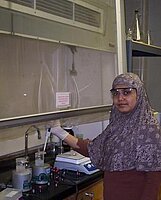Interactions between Microorganisms and Metal Nanoparticles: A New Approach for Groundwater Remediation

Rabiya Shabnam is a Master of Science student in Environmental Conservation Science program at North Dakota State University. She holds a Master of Science degree in Biochemistry (2001) from Periyar University, India, and Bachelor of Science degree in Biochemistry (1999) from Madras University, India. Her present research is focused on understanding the interactions between microorganisms and nanoparticles and how their relationship can be exploited for environmental remediation of contaminants of concern.
Email: rabiya.shabnam@ndsu.edu
Fellow: Rabiya Y Shabnam
Advisor: Achintya Bezbaruah, Ph.D., Assistant Professor, Department of Civil Engineering, North Dakota State University.
Matching Support: North Dakota State University.
Degree Progress: M.S. in Environmental Conservation Science expected in Spring 2009.
Interactions between Microorganisms and Metal Nanoparticles: A New Approach for Groundwater Remediation
Nanoparticles are attractive for remediation of various contaminants because of their unique physico-chemical properties. Zero-valent iron (nZVI) is the most popular among the metal nanoparticles used in environmental remediation. Though nZVI have been extensively used for remediation, their efficacy has been evaluated excluding their possible interactions with environmental microorganisms. The present research is based on the hypothesis that symbiotic relationships develop between introduced nZVI and microorganisms. Nanoparticles can reduce a contaminant as the first step in the degradation process and microorganism can preferentially take over the process and reduce/oxidize the degradation by-product(s) to benign end products or vice-versa. Reported work on interactions between nanoparticles and microorganisms is limited, specifically in the area of environmental engineering. The purpose of this study is to experimentally prove that microorganisms and nanoparticles develop symbiotic relationships or such relationships can be simulated under specific environmental conditions. The study will also explore possible uses of such relationships for enhanced environmental contaminant removal. Experiments will be conducted in ‘micro-reactors’ made of biopolymers (e.g. alginate). Biopolymers are used in environmental remediation for cell entrapment and in immobilization of enzymes. It is proposed to encapsulate nZVI and specific microorganisms in alginate microcapsules to study their interactions. The encapsulated microorganisms will be studied for their growth and viability. TCE will be used as the target contaminant in the initial studies. Other contaminants of concern will be used based on the results from the initial studies.
Project Objectives:
The main objective of this study is to investigate the interactions between iron nanoparticles and microorganisms. The specific objectives include:
- Design, production and characterization of alginate microcapsules
- Entrapment of nZVI and specific microorganisms in calcium alginate microcapsules
- Study nZVI-microorganism interactions in terms of microbial growth and their behavioral changes
- Conduct degradation studies for specific contaminants (e.g., TCE)
Progress:
Some progress has been made in design and production of alginate microcapsules. The capsules have been optimized for their size and properties (e.g., membrane thickness, bursting strength) for various alginate concentrations, dropping velocities, and gelation times . Entrapment of nZVI and sample microorganisms into alginate capsules has been achieved. Tracer studies using nitrate, ammonia, various polysaccharides and pesticides are underway. The tracer study results will be used to develop mathematical models for diffusion of contaminants into and out of the alginate capsules (i.e., contaminant availability for the encapsulated nZVI and microorganisms, and degradation by-product transport).
Significance:
Environmental nanoscience is one of the fastest emerging areas in the field of contaminant remediation. Successful entrapment of iron nanoparticles and microorganisms in alginate capsules will lead to possible use of these micro reactors for degrade contaminated groundwater plumes when used as permeable reactive barriers. The results of this project will also be useful for the development of household treatment system for drinking water. Most importantly this study will elucidate the nZVI-microorganism relationship that can be exploited further in other areas of science and technology.

Achintya Bezbaruah
Civil & Environmental Eng.
Office: Civil/Ind Eng 201G
Telephone: 701-231-7461
Email: a.bezbaruah@ndsu.edu


